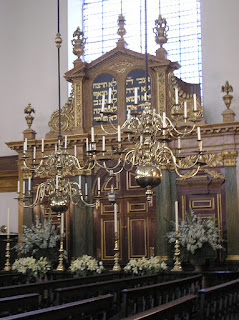 |
| Aldgate in 1610 (image is in the Public Domain). |
The poet, Geoffrey Chaucer, had lodgings in the gate-house from 1374 to 1386, whilst he was employed as a customs official. His apartment seems to have been somewhat cramped, certainly not a family home, but it was, perhaps, from here that he observed the comings and goings of knights and millers, friars and pardoners, as they made their way from Essex and East Anglia, through London on their way to Canterbury.
Many of these pilgrims would have found a bed for the night in the Augustinian Priory of Holy Trinity Aldgate, which was just inside the gate itself, its latrines inconveniently located directly beneath Chaucer's window. The priory had been founded in 1108 by Matilda, the wife of Henry I, who chose the Prior (a Norman cleric whose name was Norman) as her personal confessor. He and his brethren were not enclosed, contemplative monks, but "Austin Canons" (or "Black Canons"), priests who ministered to the spiritual needs of residents of, and visitors to, the city. Providing hospitality for pilgrims was an important part of their role. The Elizabethan chronicler, John Stow, who lived through the Reformation, and Henry VIII's dissolution of religious houses, had enjoyed the hospitality of the priory as a child, and remembered it into his old age.
"These priors have sitten and ridden amongst the aldermen of London, in livery like unto them, saving that his habit was in the shape of a spiritual person, as I myself have seen in my childhood: at which time the prior kept a most bountiful house of meat and drink, both for rich and poor, as well within the house as at the gates, to all comers, according to their estates."
He recalled, also, the destruction of the priory:
"Then was the priory church and steeple proffered to whomsoever would take it down, and carry it from the ground, but no man would undertake the offer; whereupon Sir Thomas Audley was fain to be at more charges than could be made of the stone, timber, lead, iron etc. For the workmen, with great labour, beginning at the top, loosed stone from stone, and threw them down, whereby the most part of them were broken, and few remained whole."
The music of the canons' Catholic offices may have fallen silent, but it would, in time, be replaced by religious invocations of a different sort. Edward I had, in 1290, expelled all Jews from England (a Jewish presence almost certainly remained, but any religious activities of this community necessarily took place on a covert basis. In 1657, Oliver Cromwell, as Lord Protector, approached the Sephardic Jewish congregation of Amsterdam, offering to allow a Jewish settlement in England, in return for finance for his navy. He did not, initially, allow them to establish a public place of worship, but Charles II was more relaxed about this. A small synagogue had been established on Creechurch Lane by 1665, when it was visited by Samuel Pepys. This was replaced, in 1701, by the larger Bevis Marks Synagogue, which remains to this day.
 |
| Bevis Marks Synagogue. Photo: Deror Avi, reproduced with permission. |
By the 17th Century, London was becoming increasingly important as a hub of global trade. The British East India Company, which traded in spices, cotton, silk, indigo, saltpetre and tea, was initially head-quartered within the ward in the mansion of its governor off Fenchurch Street. In 1648 it moved to another Elizabethan mansion, Craven House, which, by 1661 was known as East India House.
 |
| "Old East India House," previously Craven House, from a 17th Century Dutch print (image is in the Public Domain). |
After the Great Fire of 1666, a new East India House was established on Leadenhall Street, with warehouses accessible from Lime Street. Throughout the 18th and 19th Centuries, the building was successively enlarged and aggrandised, and the opening of East India Dock, to the east of The City, in 1802, established Leadenhall Street as the gateway to the docks, and the high seas beyond; a magnet for some of the most ambitious young men in Britain, keen to make their fortune in the orient.
 |
| East India House in 1800, by Thomas Malton the Younger, Paul Mellon Collection, Yale Centre for British Art (image is in the Public Domain). |
 |
| The sale-room of East India House, 1809, by Thomas Rowlandson and Augustus Charles Pugin (image is in the Public Domain). |
Mark Patton's novels, Undreamed Shores, An Accidental King, and Omphalos, are published by Crooked Cat Publications, and can be purchased from Amazon. He is currently working on The Cheapside Tales, a London-based trilogy of historical novels.



No comments:
Post a Comment